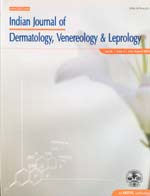
|
Indian Journal of Dermatology, Venereology and Leprology
Medknow Publications on behalf of The Indian Association of Dermatologists, Venereologists and Leprologists (IADVL)
ISSN: 0378-6323
EISSN: 0378-6323
Vol. 70, No. 5, 2004, pp. 277-279
|
 Bioline Code: dv04095
Bioline Code: dv04095
Full paper language: English
Document type: Research Article
Document available free of charge
|
|
|
Indian Journal of Dermatology, Venereology and Leprology, Vol. 70, No. 5, 2004, pp. 277-279
| en |
Study - Minimal erythema response (MED) to solar simulated irradiation in normal Indian skin
Mehta Rai Vandana, Shenoi SD, Balachandran C, Pai Sathish
Abstract
BACKGROUND:
Phototesting is an essential tool in the investigation of photodermatoses.
AIMS:
The main aim was to study the cutaneous response to UVR in terms of minimal erythema dose (MED) to both UVA and UVB in normal Indian subjects with a solar simulator and to study the relationship of skin type to MED.
METHODS:
One hundred healthy volunteers not on any medication and without any history of photodermatoses were phototested using a solar simulator with whole spectrum irradiation (UVA, UVB and visible light) and only visible and UVA radiation. The tested areas were marked with gentian violet and readings were taken after 24 hrs.
RESULTS:
Of the 100 volunteers, 48% were males and 52% were females, with a mean age of 36.6 ± 11.6 yrs. The most common skin type among Indians was type 5 (46%) followed by type 4 (41%). The mean MED for UVB was 61.5 ± 17.25J/cm2. The MED for UVA could not be determined as none of the patients showed any erythema after irradiation for 45 minutes.
CONCLUSIONS:
As the MED is found to be low in idiopathic acquired photodermatoses, the MED in the normal population could serve as a baseline data in the investigation.
Keywords
Phototesting, Minimal erythema dose, MED, Solar simulator
|
| |
© Copyright 2004 Indian Journal of Dermatology, Venereology, Leprology.
Alternative site location: http://www.ijdvl.com
|
|
